
To learn more about why we’re asking for your help identifying these apple varieties, visit this post.
Below are photos of each of the kinds of apple we were able to assemble from our orchard this year. In some cases, we’re pretty much 100% sure what they are, but many others are completely unfamiliar to us. We trust that both times trees were planted on our site, there was significant research done to ensure they are historically interesting varieties. It’s even possible that in our older orchard the variety names are all correct, just transposed onto the wrong tree.
Click on the first photo in the top left corner to open a slideshow featuring all our photos. We’ve commented on each one with whatever information or rumours we have; you’re welcome to add your own comments. (To find the comments; just click on the “comment” icon when you get into the slideshow.)
Also, you can scroll further down this page for links to some of our favourite apple-identifying resources.
Orange Pippin – Detailed information on more than 600 apple varieties.
Apple Name – This site is presented by a partnership of apple enthusiasts from the USA, Canada, and UK and includes a great set of fruit identification tools.
Fruit ID – A community-created catalogue for apple identification.


